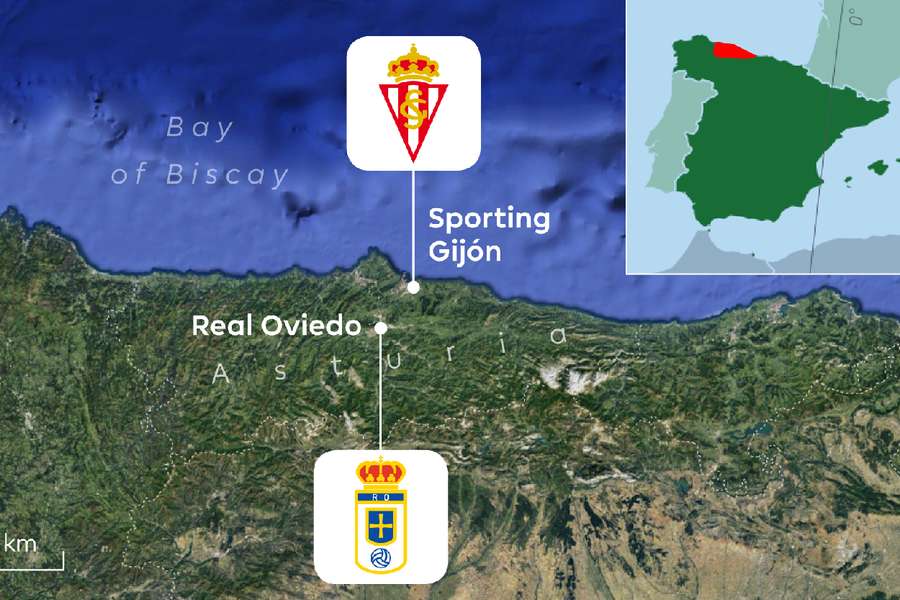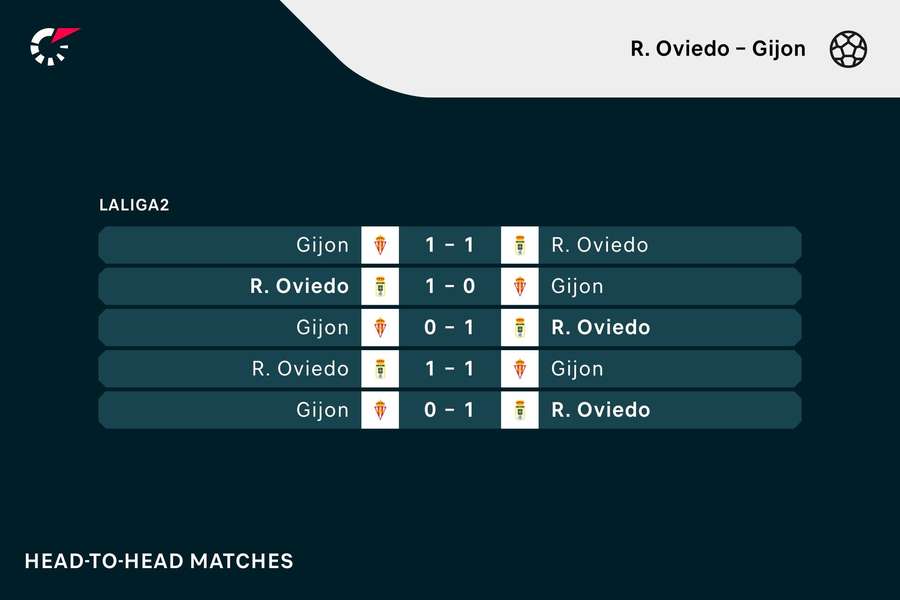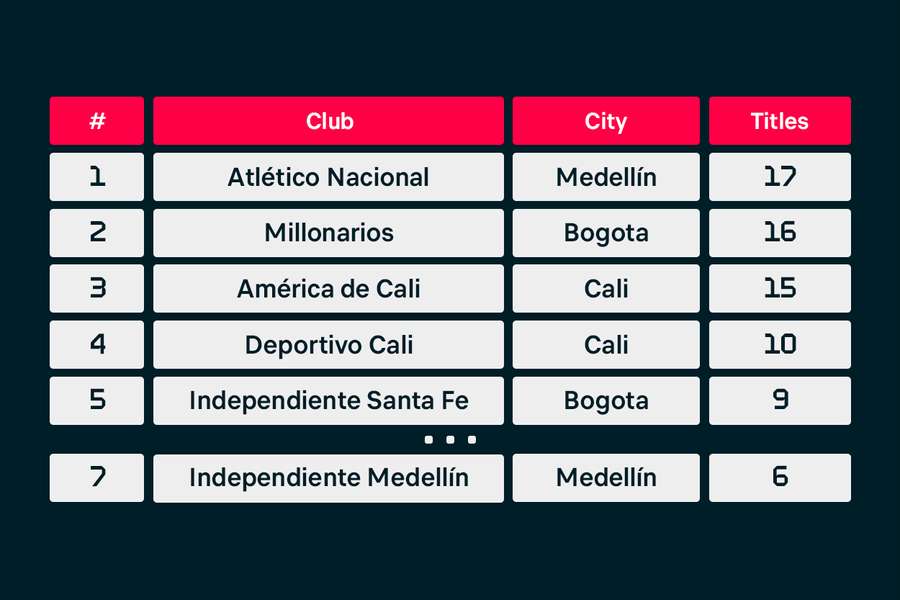Derby Week: One of the spiciest contests in Spanish football

Asturias - a spirited region and a spirited derby
Asturias, one of Spain's 17 mostly autonomous communities, has a specific personality compared to the rest of the country. It lies in the north of Spain on the Bay of Biscay. Officially, it is a principality (the King of Spain still holds the post of Prince of Asturias). However, the greater rarity that consumes everyday life is the language used. The official language in Asturias is of course Spanish, but Asturian is still quite widespread. It is spoken by about a fifth of the region's population and is also taught in schools.
Asturias is one of the weaker regions in Spain economically. This is due to its peripheral location and the fact that the Asturian economy has been based mainly on heavy industry. Since the 1960s, however, it has been in recession. Of the traditional economic activities in the region, only mountain farming (especially cow breeding) has partly survived and continues to thrive thanks to the mountainous landscape. The port of Gijon plays a strong role in the local economy. Tourism, although Asturias is beautiful and offers many historical sites (the most important being the historic city of Oviedo), is developing slowly.
It is between Gijon, the largest city in the region, and Oviedo, the capital of the Principality of Asturias, that tensions exist, stemming from the very different nature of the two settlements and their inhabitants. Disputes between the two entities have existed from the Middle Ages until recent history. After the fall of Franco's dictatorial regime and the restoration of democracy in Spain, Asturias was granted extensive autonomy as the Province of Oviedo in 1978. Naturally, Gijon had a problem with the region's new official name. Since 1982, the province has been called Asturias.

The rivalry between the two cities is also strongly reflected in football. Football is a great passion within Spain and Asturians are no different from the majority of society. On the contrary, football seems to play an even more fundamental role in the life of the local communities. Just as the cider (pronounced "sidra") - a typical Asturian drink similar to cider - is tied to Asturian culture, the Asturian derby (Derbi asturianu in Asturian, Derbi asturiano in Spanish) is also part of the local culture. And this is showcased by the clash between the two biggest clubs from two of the biggest rival Asturian cities - Real Oviedo and Sporting Gijon.
All you need to do is win the derby. That's the most important thing!
It's already been mentioned that Oviedo (Uviéu in Asturian) and Gijon (Xixón) are very different from each other, which is why there is (among other things) a football rivalry between them. Oviedo is the Asturian capital. In addition to its many cultural buildings, such as theatres, opera houses, and galleries, it boasts a UNESCO World Heritage Site, the 9th-century pre-Romanesque chapel of Camara Santa. The capital's inhabitants work mainly in the service sector. Compared to the people of Gijon, they simply feel more "posh".
Their rivals from the port city also consider them "classy", but from a slightly different perspective. Gijon is the largest city in Asturias. It has 270,000 people (50,000 more than Oviedo). A large portion of them work in the port or in the industries that service and supply the port. Their club, Sporting, profiles itself as the club of the working people of Gijon.
The rivalry between Real Oviedo and Sporting Gijon is really based primarily on the differences between the two cities and their inhabitants. In terms of sport, neither club has achieved great success, even historically. Neither Real Oviedo nor Sporting Gijon have any major Spanish trophies in their cabinets. Moreover, the two clubs have often crossed paths with each other in the league system throughout history. Neither of them are absolute regulars in the top tier - certainly not recently. Both Real Oviedo and Sporting Gijon have more than a century of tradition and they first met in 1926 (Gijon won the Asturias championship 2-1).
The Spanish league (called LaLiga or Primera Division) was founded in 1929. 155 Asturian derbies have been played since. That is why it is so important for both camps. For both Oviedo and Gijon, a win over an age-old rival is often more important than results in the rest of the competition.
A hotbed of talent
Although neither Real Oviedo nor Sporting Gijon are brimming with success in the form of trophies, they are renowned for producing great footballers. Famous Real Oviedo stars from the modern era include attacking players such as Michu (who most notably shone in the English Premier League in a Swansea City jersey), Juan Mata (e.g. Chelsea, Manchester United, now Vissel Kobe) and Santi Cazorla (Arsenal, Villarreal).
Michu came to end his career at Real Oviedo in the 2016/17 season. Santi Cazorla made a similar move in the summer of 2023, returning to help the club that nurtured him from his Qatari stint at Al-Sadd. Will this be the case for Juan Mata as well?
The most famous product of Sporting Gijon's academy (called Escuela de Fútbol de Mareo) is Spanish striking superstar David Villa (Valencia, Barcelona, Atletico Madrid and, at the end of his career, Melbourne City, New York City and Kobe).
Merging the clubs? Never!
In the period around 2000, both Real Oviedo and Sporting Gijon were in huge financial difficulties. There were rumours in Asturias that representatives of both clubs were considering a merger. The name being touted was Real Asturias, for which a stadium would eventually be built halfway between the two cities 24 kilometres apart. The project of a joint stadium between Gijon and Oviedo was meant to soften the blow for supporters of both teams, to at least lull them into the knowledge that they would not have to travel to their hated neighbouring city for their new team's matches.
But it didn't work. There was strong opposition to the idea from both camps, not only from the fans but also from the various companies and corporations behind the teams. The merger did not go through, leaving both clubs in a bleak situation.
Oviedo, however, were much worse off. Real Oviedo, who in the 2000/2001 season were still competing with the best in LaLiga, found themselves three tiers below a few years later (in the summer of 2003, the club was relegated from the second division straight to the fourth due to their debts).
Fans ended up buying over 10,000 season tickets for the 2003/2004 season, an absolute record for the fourth league in Spain. Real Oviedo supporters later set a similar record, when the club had 20,800 season ticket holders for the 2017/2018 season (Estadio Carlos Tartiere holds 30,500 spectators).
Asturias is dominated by blue
It was in the 2017/2018 season that the two Asturian rivals met again in the Segunda Division as Sporting Gijon were relegated from LaLiga. The Asturian derby returned to the scene after 14 long years and the atmosphere was really tense. The streets of Gijon looked like a battlefield. Lots of skirmishes, flares, stones and even chairs from restaurants were flying through the air. This match ended in a 1-1 draw.
Since 2017, the Asturian derby has been played 12 times. Based on the results of these encounters, Oviedo currently reigns supreme. Los Azules (The Blues), as Real Oviedo's footballers are nicknamed, have won seven derbies and drawn four, while the Rojiblancos (Red and Whites) of Sporting Gijon have won just once.

Real Oviedo have not started this season well at all. After four rounds, they have just two points and sit in last place. It is now all the more important for them to clinch the win in the derby. Gijon on the other hand, has six points (two wins, two losses).
Meanwhile, Santi Cazorla is targeting a return soon. Will he at least be on the bench for the game against rivals Gijon and help his team to their first win of the season?
Follow the first Asturian derby of the season on Flashscore.
Other derbies of the week - a trio of Colombian clashes
The Colombian league continues despite the national break as the national team is made up of a vast majority of players based in Europe or other American countries. Three giant derbies will be played in the three biggest cities in the country during the international break.
Meanwhile, the national team play Venezuela at home in the South American qualifiers on Friday, September 8th (which is also a big derby - the rivalry between the two countries permeates into geopolitical disputes), and on Wednesday, 13th September, they play Chile. Colombia are set for a great week of football.

All six teams involved in this weekend's derby are among the seven most successful clubs in the country in terms of championship titles. The Colombian league has been played since 1948, and the 2023 season is its 76th.
Sunday, September 10th
Colombia - Primera A
Independiente Medellin vs. Atletico Nacional
El Clásico Paisa (The "Real Clásico")
Medellín is the second largest city in Colombia, home to over 2.5 million people. It is home to two major football clubs - Atletico Nacional and Independiente Medellin. Their rivalry is referred to as El Clásico Paisa, or "The Real Clásico" (paisa is a slang word meaning "the real home team"). The two clubs share the 40,000-seat Estadio Atanasio Gigardot, which is a hell on earth, especially during the city's derby.
Colombia - Primera A
America de Cali vs. Deportivo Cali
Clásico Vallecaucano ("Clásico" of the Valle del Cauca department)
Cali is Colombia's third-largest city, with a population of over 2.2 million. It is also home to two large and successful clubs. These are America de Cali and Deportivo Cali. The Clásico Vallecaucano has been played 335 times in history. Both clubs have achieved continuously good results, almost throughout their existence. Therefore, they are evenly matched and the rivalry is very strong.
Colombia - Primera A
Millonarios vs. Independiente Santa Fe
Clásico Bogotano (Bogotá Clásico)
Bogotá, the capital of Colombia, has eight million inhabitants. The population of the metropolis is basically divided into two halves. One favours the Millonarios, the other the Independiente Santa Fe. The Clásico Bogotano, or also the Clásico Capitalino ("Clásico" of the capital), is the most traditional Colombian derby. Both clubs are among the trio of teams (along with Atletico Nacional) that have never been relegated from the Colombian top division.
Rivalry between clubs and drug cartels
In conclusion, Colombian football and the rivalries between some clubs (and entire cities and regions) have changed significantly during a period when life throughout Colombia was profoundly affected by the drug cartels. With many drug lords wielding enormous influence in football, the cartel war often spilt over onto the football pitch. More on the murky connection between drug cartels and football in Colombia, and the complex and bitter rivalries involved, in a future Derby Week.
